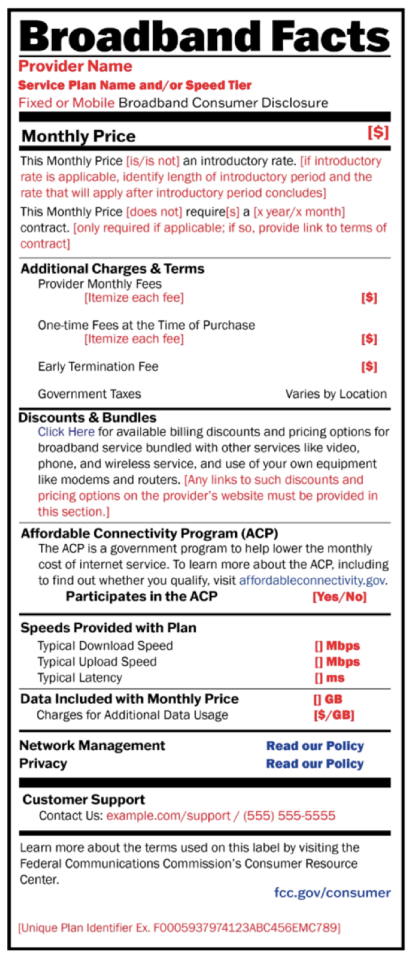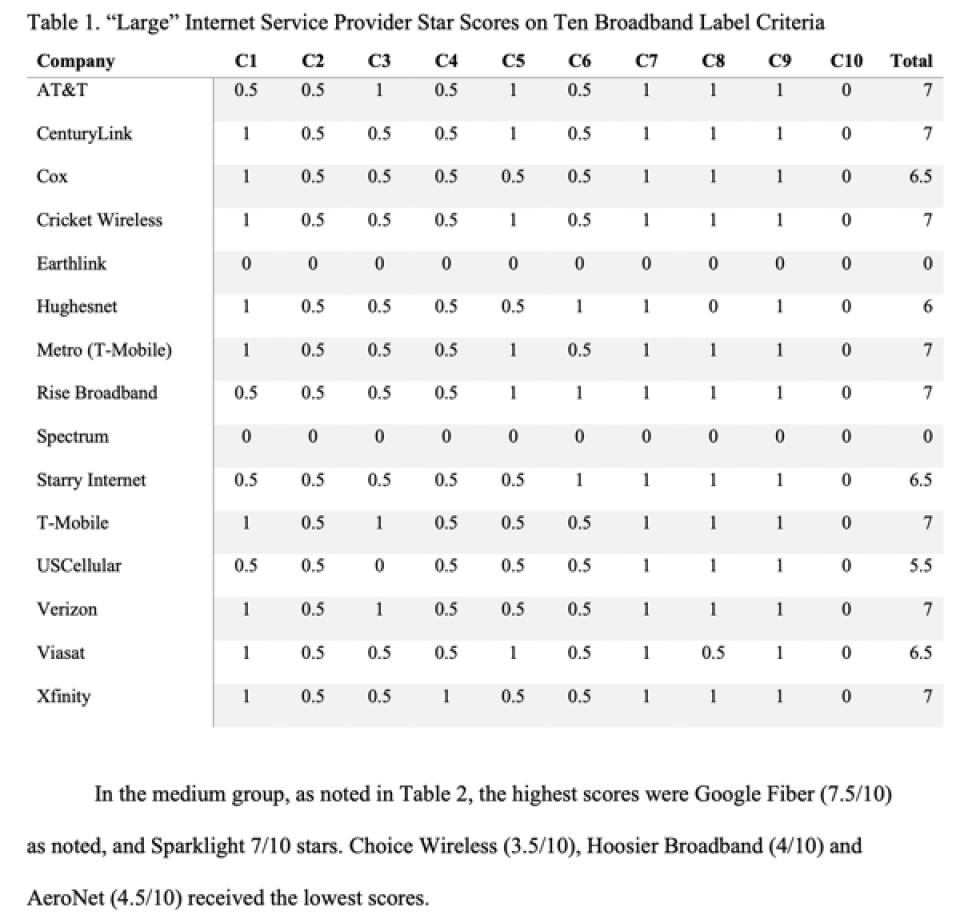
Last year the Biden FCC implemented a new rule requiring that broadband providers include a “nutrition label for broadband,” making any fees, restrictions, usage caps, or other limits clear at the point of sale. The proposal was mandated by Congress as part of the bipartisan infrastructure law.
But four years after Congress proposed the idea, a new study indicates that many ISPs aren’t doing a great job adhering to the rules. The Trump FCC has also announced that it's taking formal steps to weaken or eliminate the rules as part of the agency’s broad, frontal assault on consumer protections.
The new academic study (first reported on by Broadband Breakfast) by York University researchers Jonathan A. Obar and Boxi Chen gave 35 different U.S. ISPs a ten-star based grade on how well they are adhering to the FCC broadband label requirements, including label placement, standardized formatting, machine-readable data files, and required policy links.
The results weren’t pretty: only sixteen ISPs properly placed labels at the point of sale as required, and not a single ISP received full marks for completely adhering to the FCC’s requirements. Only six ISPs received a full ten star ranking for proper formatting.

While the study found most ISPs properly adhered to requirements that they display upstream and downstream speeds, such advertised speeds often have a long history of being unreliable and generally overstated. None of the carriers studied added voluntary accessibility features like video or audio content aimed at helping the visually or hearing impaired.
“The average across the sample was 5.2/10 stars,” the authors noted. “Across the 15 large ISPs assessed the average score was 5.8/10. Across the 12 medium ISPs assessed the average was 5.4/10 stars, and the average across the eight small ISPs, the average score was 3.75/10 stars.”
The disparity in performance among smaller ISPs may be due to smaller providers lacking the staff or resources to comply with federal regulations. Requirements (as we saw with net neutrality) that are often ironically only necessary due to the bad behavior of the industry’s biggest players.
The 2021 infrastructure bill – also known as the Infrastructure Investment and Jobs Act – directed the FCC to implement new consumer broadband labels that closely resemble existing nutrition labels. The goal was to mandate transparency ahead of a massive and historic new influx of federal broadband deployment grants and subsidies to broadband ISPs.
The effort came after decades of criticism of broadband providers for failing to be transparent about broadband connection prices, speeds, and other limitations. For example, many ISPs advertise one rate, then sock consumers with significantly higher costs via a rotating array of misleadingly named fees and surcharges.
One 2019 study by GlobalData found that what consumers will actually pay their cable TV or broadband provider could often be upwards of 45 percent higher than the advertised price. Usage caps and overage fees – often little more than a tax on captive customers in uncompetitive broadband markets – can drive up monthly broadband costs even higher.
Historically the FCC not only hasn’t penalized ISPs for misleading pricing, it has refused to gather and publicize consumer broadband pricing data, or seriously address the predatory nature of unnecessary broadband usage caps. As such the nutrition label, while well intentioned, wound up being a band aid on a much bigger, long unaddressed problem.
Transparency Doesn’t Fix Monopoly
While the FCC was lauded on some fronts for efforts to mandate ISP transparency, the program wasn’t without criticism. Consumer advocates were quick to warn that the nutrition label wouldn’t be useful if ISPs weren’t required to display them prominently. With roughly half of ISPs failing at this basic task, those concerns appear warranted.
The transparency requirements also don’t actually address the real underlying cause of consumer-facing problems across the U.S. broadband market: a lack of competition and the spotty coverage, slow speeds, high prices, and poor customer service that result.
Government requirements that regional monopolies be transparent about the fact they’re ripping you off – doesn’t do anything to prevent those regional monopolies from ripping you off.

Transparency into billing and pricing isn’t as useful if impacted consumers – frustrated by high prices or misleading fees – have no alternative providers to flee to.
The nutrition label effort, while well intentioned, obscured a problematic reality.
The FCC, under both parties, has historically lacked the courage to address (or often even mention) the real cause of U.S. broadband market failure: unchecked monopoly power.
That’s been broadly reflected in the agency’s failure to maintain modern definitions of broadband access; as well as in the agency’s ongoing failure to meaningfully and publicly support the steady rise in municipal broadband networks, a grass roots, organic, popular response to unchecked corporate consolidation.
Rules are also only as good as enforcement. The FCC historically hasn’t done a good job holding major ISPs accountable for a wide variety of anti-competitive behavior, from privacy abuses to billing fraud. As Trump-stocked courts have increasingly curtailed the FCC’s power, it’s more difficult than ever to hold big telecoms accountable for any offenses.
Rules Now Risk Being Weakened To The Point Of Pointlessness
Obar and Chen’s study simply doesn’t mention that the nutrition label’s good intentions have been undermined by a lack of enforcement, a problem that’s only getting worse as the Trump administration takes a calculated hatchet to the regulatory state.
On October 30, the The Trump FCC under Brendan Carr voted in favor of a Notice of Proposed Rulemaking (NPRM) to eliminate or weaken the rules; especially requirements that ISPs transparently detail itemized fees buried in their advertised prices. Big ISPs like Comcast have repeatedly complained that being clear and honest about their pricing is simply too difficult.

"We propose to eliminate the requirement that providers itemize discretionary, recurring monthly fees that represent costs they choose to pass through to consumers and which vary by consumer location," Carr's draft proposal said.
But again, the only folks actually asking for these rules to be weakened and eliminated are major telecom giants, which artificially advertise one, false, lower rate, then sock captive customers with a bevy of confusing and misleading fees and surcharges. Carr neither announced or justified the October 30 vote.
“What adds insult to injury is that the FCC does not even explain why this proposal is necessary,” sole FCC Democratic Commissioner Anna Gomez said of the retreat. “Make it make sense. Instead of scaling back the information that customers receive, we should be making sure that, in fact, they can benefit from the labels.”
Carr doesn’t want to give the overt impression he’s ignoring the direct demands of Congress to aid industry giants, so consumer groups suggest he’s going to weaken the rules to the point of uselessness to justify future efforts to dismantle them entirely.
“It’s the start of whittling away at these rules,” Raza Panjwani, senior policy counsel at New America’s Open Technology Institute, told CNET. “You get this two-step, right? You make it less useful. Then you say, ‘Oh, look, it's not that useful. We should get rid of it.’”
The FCC’s clumsy and seemingly doomed effort to mandate transparency is another clear example of why regulators looking to address problems in U.S. broadband are better off taking direct and aggressive aim at the actual heart of the industry’s dysfunction: unchecked regional telecom monopoly power – and the state and federal political support that historically coddles it.
Header image of pro Net Neutrality protest in front of FCC entrance courtesy of the Free Press on Flickr, CC BY-NC-SA 2.0, Attribution-NonCommercial-ShareAlike 2.0 Generic
Inline image of broadband nutrition label courtesy of York University study
Inline table of ISP broadband nutrition label scores courtesy of York University study
Inline image of FCC Chairman Brendan Carr courtesy of Broadband Breakfast







